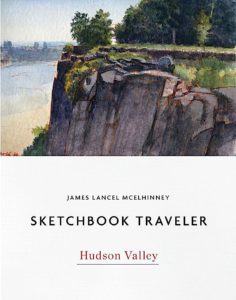Waiting for the crisis to pass, our thoughts go out to friends and loved-ones who also shelter in place. Old friends pass away, people we loved and admired. Immobilized for the time being, we can revisit destinations, near and far. join me in celebrating the joys of Quaranteam travel, the hope that these diversions might inspire us to value things we had taken for granted, to draw strength, wisdom and compassion from deeper engagements with nature.

View of Yonkers from State Line Overlook. Alpine. New Jersey. Thursday August 4, 2016
(Image and text were featured in the exhibition James McElhinney. Discover the Hudson Anew, curated by Laura Vookles. Hudson River Museum. Yonkers, New York. September 13, 2019 to February 16, 2020. Published also as a limited-edition in Hudson Highlands. North River Suite Volume One. Needlewatcher Editions. New York. 2018)
The Palisades Interstate Park Commission was created in 1900, by a mutual agreement between the states of New York and New Jersey to preserve the natural environment on the right bank of the Hudson River, and to protect the Palisades from being quarried like Hook Mountain, an extension of the same basaltic sill that rises up from the northwestern shores of Tappan Zee. Parklands atop the Palisades are traversed by The Long Path—an historic trail, now part of the Empire State Trail. A short distance south of the boundary-line between the two states the trail reaches State Line Overlook, which is also accessible from the northbound lanes of the Palisades Interstate Parkway. A large parking lot serves the café, visitor center and book-store. The path at this point is macadamized. Several walled promontories have been built at the very edge of the cliffs. Looking north across the river one finds the village of Hastings-on-Hudson, with Dobbs Ferry beyond. To the south are wooded hills occupied by Lenoir Preserve, Untermeyer Gardens and Trevor Park. Beyond, the warm tones masonry and tall buildings mark the location of downtown Yonkers. I took note of the number of oceangoing ships and oil barges that pass by, trying to envision the Hudson in 1820, with its quotidian flotilla of several hundred steamboats and sailing-vessels plying its waters, a major artery of trade and empire.
In 1820, Irish-American topographical artist William Guy Wall traveled the length of the Hudson River with travel-writer John Agg. Wall produced sketches and watercolors of sites they visited, while Agg captured them in words. The following year Wall’s pictures and Agg’s prose were published together by Henry L. Megary starting in 1822. Hudson River Portfolio: Twenty=Four Views on the North River consisted of hand-colored aquatints of compositions by Wall, produced by master-printer John Hill. Agg’s texts were presented as letterpress texts alongside Wall’s pictures. Prints were issued in suites of four. Wrapping the sets in blue paper sent a subliminal message to purchasers. Sugar-cones were at the time were marks of affluence and refinement. These were also wrapped in blue paper at point-of-purchase. Agg writes,
“Oak, hickory, chestnut, butternut and maple, are to be found among the trees that adorn the summit of the Pallisadoes, and grow to a magnitude which would scarcely be credited…Considerable quantities of wood are annually cut from this abundant source, and being plunged down the precipice, are easily thrown into vessels which lie close under the shore…rising from 400 to 800 feet, exhibiting i. every interval of verdure, steep and solid masses of stupendous stone…where the eagle builds his nest among the cliffs, secure from the reach of human enmity.”

No. XIX Of The Hudson River Port Folio. THE PALLISADOES.(Metropolitan Museum of Art. Reproduced according to fair use, etc.)
A significant number of Wall’s views represent waterfalls, suggesting that one of the goals of his project had been to promote industrial development of the upper Hudson. Only twenty of the twenty-four intended views were actually produced. One suspects the project was abandoned for commercial reasons. The Erie Canal opened for traffic in 1825. Investors looked to the west for more fertile opportunities than the foothills of the Adirondacks.

In 1859 Benson John Lossing (1813 – 1891) traveled with his new bride and a male companion from New York City to the summit of Mount Marcy. Their party was led by Abenaki guide Mitchell Sabbatis, who later guided Winslow Homer on treks into the mountains. From Newcomb the trio descended the Hudson to its mouth. Publication of his account of the jounrey was delayed by four years of Civil War. In 1866 H.B. Nims & Company of Troy, New York published The Hudson From the Wilderness to the Sea. Unlike Wall and Agg, Lossing both wrote the texts and produced the illustrations. An excerpt:
“Here the Palisades proper have their northernmost termination; and from here to Fort Lee their columnar range is almost unbroken. This place is better known as Sneeden’s Landing. Here Cornwallis and six thousand British troops landed, and marched upon Fort Lee…The dividing line between that state (New Jersey) and New York is a short distance below Rockland, or Sneeden’s Landing; and it is only a short distance from between there and its mouth (about twenty miles) that that the Hudson washes any soil but that of the State of New York.”
My own Hudson River journey has been fragmented, spanning more than a decade of day trips, overnights and weekends. Both Wall and Lossing provided me with narrative models in a way similar to the late Don Nice (1932-2019) following Jacques-Gerard Milbert’s 1828-1829 Itineraire Pittoresque du fleuve Hudson et des Parties Laterales de l’Amerique du Nord on his toru of the Hudson during the 1980s.

Revisit April’s QT Traveler Dispatches, day by day.
(A preview of SKETCHBOOK TRAVELER by James L. McElhinney (c) 2020. Schiffer Publishing).
Copyright James Lancel McElhinney (c) 2020 Texts and images may be reproduced (with proper citation) by permission of the author. To enquire, send a request to editions@needlewatcher.com
